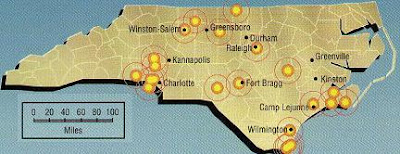 |
| WOPR (pronounced "Whopper") is a fictional military computer featured in the movie WarGames and was based on NORAD's real life SIOP (Single Integrated Operational Plan) |
Today's Red-Scare is much different from years past, when Americans feared communist USSR. The idea of missile silos popping open on a near by farm, with Inter-continental ballistic thermonuclear missiles, was always in the back our minds. Hollywood perpetuated the phobia with a lovely movie called "War Games", where a young boy competed with a super-computer called WOPR in a game of tic-tac-toe, to stop the launching of the nuclear missiles.
Today, we've tried to forget about the cold war, yet thousands of nuclear ICBMs linger, scattered throughout the US. I personally, was under the belief we've cut back, dismantled, and barely had a nuclear arsenal, but just the opposite is true. In the heart of the US, in just the states of Colorado, Wyoming, Nebraska, Montana, and North Dakota, there's over 500 long-range nuclear missiles on high alert that can be launched in under four minutes.
With this sort of threat, and our modern technology, I figured I better check and see how darn close the nearest missile silo is to Greensboring.com's secret lair. Unfortunately, the U.S. Government didn't seem to post a PDF on the location of their nuclear silos. What's worst is they didn't even attempt to map them out on Google Maps like the Russians were kind enough to do.
In the worse case scenario if a ICBM from China, Iran or Russia was launched, you've got less than seven minutes to Google your escape route and get the heck out of North Carolina. Yes, it may be too late, but what should we expect here in the good ole' north state? Bruce Irby, my 7th grade teacher used to tell us "kiss your butt goodbye", but I don't give up that easy. I say "tonight we dine in Hell."
The above map is a 1990 FEMA publication. The red ring indicates 25% casualties, the orange ring indicates 50% casualties, and major building damage, and that yellow dot? Complete and unimaginable destruction. If you live in any of these targets, you will be part of any first strike initiative.
If you've survived the initial blasts, or you have time to react, you'll want to follow the number one rule for survival:
Stop Drop & Roll?
Nope, that's not it...
Duck & cover?
Nope, not that either...
GET THE HELL OUT OF THE CITIES!
 The second rule of survival, be aware of the winds. Radiation travels with the wind, and while there is no way to be certain of where the radiation will travel following a post apocalyptic nuclear attack, it's so important FEMA suggests you reference and understand prevailing US winds to predict fallout.
The second rule of survival, be aware of the winds. Radiation travels with the wind, and while there is no way to be certain of where the radiation will travel following a post apocalyptic nuclear attack, it's so important FEMA suggests you reference and understand prevailing US winds to predict fallout.If you've survived this long, you need to consider the three following things to get you by the next few days, weeks or months. You'll need shelter, food, and supplies. It's easier to join another group of people to combine each others skills and power for survival. The best thing to do at this point is to find a fallout shelter. This is where sheer luck is going to have to come in handy. Many homes built in the 1950s-70s were constructed with them, as well as many public buildings still contain a fallout shelter. This needs to be done quickly before a second wave of assault occurs. As a last resort, tunnels, caves, overpasses, ditches, cars, or homes can be used.
Four major factors will probably consider if your shelter helps you survive:
1) Time exposed
2) Amount of shielding
3) Distance from fallout
4) Time since explosion.
After 7 hours following the last bomb: 90% of radiation is gone.
After 14 days, 99% of radiation is gone.
The following shielding will stop the majority of radiation:
16 inches of brick or concrete
2 feet of earth
5 inches of steel
3 inches of lead
3 feet of water
During the wait, you'll want a radio to be able to receive news and information. It also helps you recognize the amount of time gone by. Expect to spend 14 days in your shelter.
And if you survive that.... well then find the server we host on, rig up the generator, and put Greensboring.com back on the web. Yes the future is in your hands.
